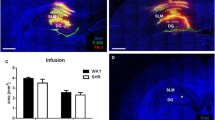Summary
Focal areas of recent and old necrosis are a consistent finding in brain in chronic hypertension. The possibility that areas represent foci of increased vascular permeability leading to chronic edema and tissue breakdown was investigated in the present study.
Rats with chronic renal hypertension demonstrated increased cerebrovascular permeability in focal cortical areas throughout the 7-week period of study. Combined use of tracers and immunohistochemistry demonstrated that these areas of increased permeability with protein extravasation were of different ages. Stage I lesions showed protein in and around arteriolar walls with no cellular reaction indicating that these were very early lesions and corresponded to the findings using HRP as a tracer. Necrosis of the neuropil and an astrocytic and microglial response associated with diffuse collections of protein in the neuropil characterized stage II lesions. Stage III lesions consisted of glial scars or cystic spaces lined by astroglia and associated with absent or sparse protein deposits. Animals that died or were sick prior to killing and had diffuse cerebral edema showed large stage II cortical lesions associated with widespread serum protein extravasation into the white matter of both hemispheres.
The principal mechanism resulting in the permeability alterations was enhanced pinocytotic transport of tracer across the endothelium of penetrating cortical arterioles. Vascular occlusion by thrombi was not observed in pial or intracerebral vessels.
Our findings are consistent with the hypothesis that increased vascular permeability leads to chronic edema and tissue necrosis in chronic hypertension.
Similar content being viewed by others
References
Byrom FB (1954) The pathogenesis of hypertensive encephalopathy and its relation to the malignant phase of hypertension. Lancet II:201–211
Chester EM, Agamanolis DP, Banker BQ, Victor M (1978) Hypertensive encephalopathy: A clinicopathologic study of 20 cases. Neurology 28:928–939
Cervos-Navarro J, Matakas F, Roggendorf W, Christmann U (1978) The morphology of spastic extra-cerebral arterioles. Neuropathol Appl Neurobiol 4:369–379
Chui E, Wilmes F, Sotelo JE, Horie R, Fujiwara K, Suzuki R, Klatzo I (1981) Immunocytochemical studies on extravasation of serum proteins in cerebrovascular disorders. In: Cervos-Navarro J, Fritschka E (eds) Cerebral microcirculation and metabolism. Raven Press, New York, pp 121–127
Farrar JK, Jones JV, Graham DI, Strandgaard S, Mackenzie ET (1976) Evidence against cerebral vasospasm during acutely induced hypertension. Brain Res 104:176–180
Fisher CM (1969) The arterial lesions underlying lacunes. Acta Neuropathol (Berl) 12:1–15
Giacomelli F, Wiener J, Spiro D (1970) Cellular pathology of experimental hypertension. V. Increased permeability of cerebral arterial vessels. Am J Pathol 59:133–159
Giese J (1964) Acute hypertensive vascular disease. 2. Studies on vascular reaction patterns and permeability changes by means of vital microscopy and colloidal tracer technique. Acta Pathol Microbiol Scand 62:497–515
Graham RC, Jr, Karnovsky MJ (1966) The early stages of absorption of injected horseradish peroxidase in the proximal tubules of mouse kidney: Ultrastructural cytochemistry by a new technique. J Histochem Cytochem 14:291–302
Johansson BB, Linder LE (1978) Reversibility of the blood-brain barrir dysfunction induced by acute hypertension. Acta Neurol Scand 57:345–348
Karnovsky MJ (1967) The ultrastructural basis of capillary permeability studied with peroxidase as a tracer. J Cell Biol 35:213–236
Nag S, Robertson DM, Dinsdale HB (1977) Cerebral cortical changes in acute experimental hypertension. An ultrastructural study. Lab Invest 36:150–161
Nag S, Robertson DM, Dinsdale HB (1979) Quantitative estimate of pinocytosis in experimental acute hypertension. Acta Neuropathol (Berl) 46:107–116
Nag S, Robertson DM, Dinsdale HB (1980) Morphological changes in spontaneously hypertensive rats. Acta Neuropathol (Berl) 52:27–34
Ogata J, Fujishima M, Tamaki K, Nakatomi Y, Ishitsuka T, Omae T (1980) Stroke-prone spontaneously hypertensive rats as an experimental model of malignant hypertension. I. A light- and electron-microscopic study of the brain. Acta Neuropathol (Berl) 51:179–184
Ogata J, Fujishima M, Tamaki K, Nakatomi Y, Ishitsuka T, Omae T (1981) Vascular changes underlying cerebral lesions in stroke-prone spontaneously hypertensitive rats. A serial section study. Acta Neuropathol (Berl) 54:183–188
Robertson DM, Dinsdale HB, Hayashi T, Tu J (1970) Cerebral lesions in adrenal regeneration hypertension. Am J Pathol 59: 115–131
Rosenberg EF (1940) The brain in malignant hypertension. A clinicopathological study. Arch Intern Med 65:545–586
Spielmeyer W (1928) Vasomotorisch trophische Veränderungen bei zerebraler Arteriosklerose. Monatsschr Psychiat Neurol 68: 605–620
Sternberger LA (1979) Immunocytochemistry, 2nd ed. Wiley, New York, pp 104–169
Westergaard E, van Deurs B, Brondsted HE (1977) Increased vesicular transfer of horseradish peroxidase across cerebral endothelium, evoked by acute hypertension. Acta Neuropathol (Berl) 37:141–152
Wolman M, Klatzo I, Chui E, Wilmes F, Nishimoto K, Fujiwara K, Spatz M (1981) Evaluation of the dye-protein tracers in pathophysiology of the blood-brain barrier. Acta Neuropathol (Berl) 54:55–62
Author information
Authors and Affiliations
Additional information
Supported by Ontario Heart Foundation grant 2-6
Rights and permissions
About this article
Cite this article
Nag, S. Cerebral changes in chronic hypertension: Combined permeability and immunohistochemical studies. Acta Neuropathol 62, 178–184 (1984). https://doi.org/10.1007/BF00691850
Received:
Accepted:
Issue Date:
DOI: https://doi.org/10.1007/BF00691850




